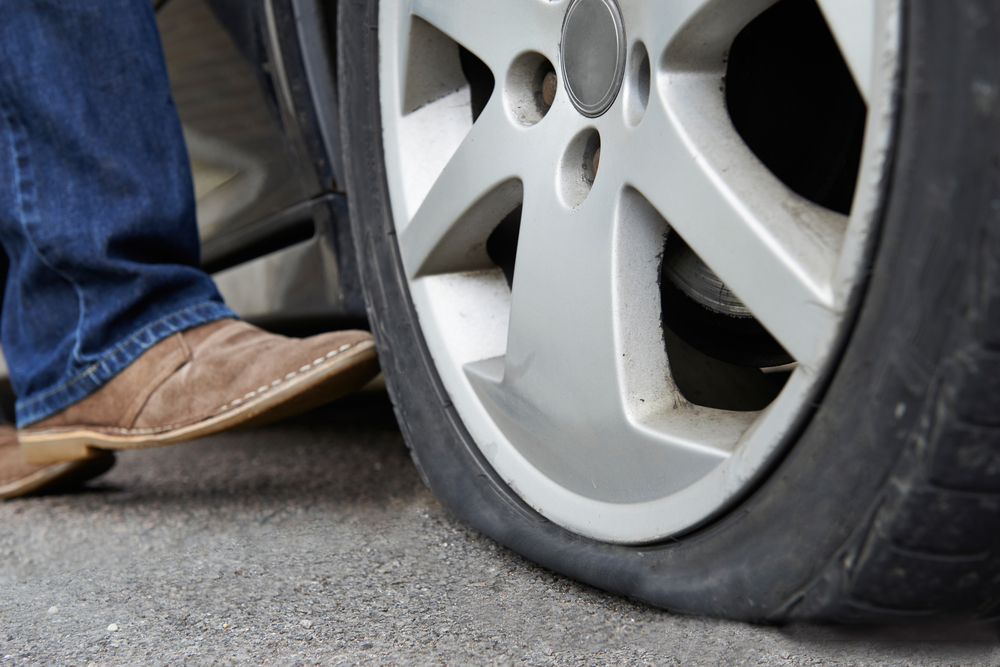
Items Needed to Change a Car Tire
New cars come equipped with the basic items needed to change a tire, but over time they may be misplaced. If you bought a used car, it could be missing some, or all, of the things you need to change a tire. Check your car for these essentials and replace any items you don’t find.
Vehicle Owners Manual
Your vehicle owners manual may contain specific instructions for changing the tire on your make and model of vehicle. If you don’t have a vehicle owners manual, order one online.
Jack
A car jack lifts your car off the ground so you can change the tire. For safety reasons, always use the type of jack your owners manual recommends and never use any other object to lift or prop up your vehicle. If you need a jack, read our review of the best car jacks on the market.
Lug Wrench
This tool has a pry bar on one end to remove the hubcap and a socket on the other end to loosen the lug nuts that hold your tire in place.
Spare Tire
There are two basic types of spare tires: full size and temporary (sometimes referred to as “donuts”). Larger vehicles like SUVs and trucks usually have full-size spare tires, while compact cars tend to come with temporary tires.
Things that Make Changing a Flat Tire Easier and Safer
In addition to the essentials outlined above, there are a few things SafeWise recommends having on hand to make changing a tire easier and less dangerous. Pack these items—along with a first aid kit, bottled water, and other safety items—in a durable bag and stow them in your car. Or purchase a roadside emergency kit that contains most, or all, of these things.
Emergency flares or reflective triangles to alert motorists to your disabled vehicle.
Tire blocks or wedges to help prevent the car from rolling.
Tire-changing mat or towel to kneel on.
Lubricant to loosen tight lug nuts.
Flashlight, with working batteries, for changing a tire in the dark.
Tire pressure gauge to check the spare tire’s air pressure.
Hand wipes to clean up after changing the tire.
Rain jacket or poncho to help keep dry or protect you from the sun.
How to Change a Car Tire Step by Step
If you’re driving when you get a flat tire, slowly decrease your vehicle’s speed, turn your car’s hazard lights on, and look for a safe place to stop. If possible, pull into a parking lot with open space or find another low-traffic area.
If you’re driving on the highway and can’t get off, pull on to the shoulder of a straight stretch of road. Find a level area if you can—this will help minimize the risk of your vehicle moving while you’re changing the tire. Once your car is stationary, follow these steps.
Step 1. Set Parking Brake
Once stopped, put your car in park and engage the parking break. This is another safety measure to help your car remain in place while you change the tire.
Step 2. Put Out Warning Devices
If you have flares or reflective warning triangles, set them out according to product instructions. Use extreme caution and never turn your back to oncoming traffic.
Step 3. Place Wheel Wedges
Wheel wedges help prevent your car from moving. When changing a front tire, place them behind your car’s rear tires. When you change a rear tire, place them in front of the car’s front tires.
Step 4. Remove Hubcap
Next, you need to remove the hubcap. This is necessary so you can get to the lug nuts that secure your tire to the car. Use the pry bar (the lug wrench’s flat end) to pop the hubcap off the tire rim.
Step 5. Loosen Lug Nuts
Place the lug wrench (socket end) over the lug nuts and turn it counterclockwise until the lug nuts are loose, but not completely off. Some lug nuts are difficult to loosen, so don’t be surprised if you have to use a great deal of force.
Step 6. Position Jack Under Your Car
The best place for a jack is under the vehicle frame, next to the flat tire. For safety and to avoid damaging your car, consult your vehicle owners manual for specific instructions on where, and how, to place the jack.
Step 7. Lift Vehicle Using Jack
Pump the jack slowly until the flat tire is off the ground. Make sure none of your or anyone else’s body parts go under the car while you’re raising it or once it’s raised. If your car moves while it’s on the jack, don’t try to stop it. Move away from your car and wait for it to fall, then try again.
Step 8. Completely Unscrew Lug Nuts
With the lug nuts already loose, finish unscrewing them by hand. Put the lug nuts in a safe location so they aren’t misplaced.
Step 9. Remove Flat Tire
Pull the tire toward you to remove it from the hub, then place it on its side and out of your way.
Step 10. Mount Spare Tire
Line up the spare tire with the lug bolts and push it on the wheel hub until the bolts penetrate the rim.
Step 11. Replace Lug Nuts
Place the lug nuts on the lug bolts and tighten them down by hand. Don’t use the lug wrench to secure them yet.
Step 12. Slightly Lower Vehicle
Using the jack, lower your car until the spare tire touches the ground. Be careful not to lower it to the point where it bears your vehicle’s whole weight.
Step 13. Tighten Lug Nuts with Wrench
Tighten down the lug nuts by turning the wrench clockwise as much as you can. It’s important to tighten the lug nuts in the correct sequence to help ensure they stay secure on the hub.
Step 14. Finish Lowering Vehicle
Lower your car completely and remove the jack. Tighten your wheel’s lug nuts one more time, using the same pattern as you did in the previous step.
Step 15. Put Hubcap Back On
If the hubcap you removed fits the spare tire, put it back on.
Step 16. Check Tire Pressure
Before you drive off, check the spare tire’s air pressure. If the tire needs air, drive to the closest gas station and fill it to the manufacturer’s recommended PSI.
Step 17. Return All Equipment and Supplies to Your Vehicle
Gather all the items you used and secure them in your car. Be sure to stow your owners manual, jack, and lug wrench in their proper places.
Step 18. Get Your Flat Tire Fixed
It’s dangerous to drive on a spare tire for long distances so take your flat tire to a professional auto repair shop and have it fixed or replaced as soon as possible.
Sources: https://www.safewise.com/blog/properly-change-flat-tire/
